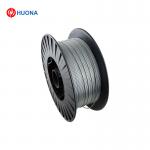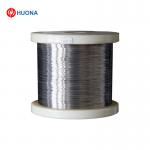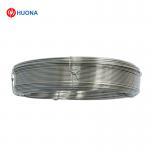Kovar Alloy Wire Material 4j29 Ni29co17 Kovar WIRE Precision Alloy
Invar36 Nilo42 4j42 Iron Nickel Constant Expansion WIRE Product Introduction – 4J29 Alloy Wire Rod (Kovar Equivalent)4J29, also known as Kovar in international standards, is a Nickel–Iron–Cobalt controlled expansion alloy engineered for glass-to-metal and ceramic-to-metal sealing. Its thermal expansion closely matches that of hard glass and
alumina ceramics, making it an ideal material for hermetic packaging, vacuum electronics, and aerospace components. As a wire rod, 4J29 is supplied in spooled wire, straight rods, or custom-cut lengths, with tight dimensional tolerances and excellent surface finish. Technical Specifications: Precision alloys are metal materials with special physical
properties (such as magnetic, electrical, thermal and other
properties). The vast majority of precision alloys are based on
ferrous metals, and only a few are based on non-ferrous metals.
Usually include magnetic alloys (see magnetic materials), elastic
alloys, expansion alloys, thermal bimetals, electrical alloys,
hydrogen storage alloys (see hydrogen storage materials), shape
memory alloys, magnetostrictive alloys (see magnetostrictive
materials), etc. | Industry | Application Examples |
|---|
| Electronics | Glass-to-metal seals for vacuum tubes, transistor cans,
semiconductor housings | | Aerospace | Seals for sensors, connectors, and components in aerospace systems | | Telecommunications | Microwave and RF components, fiber optic connectors, satellite
components | | Medical Devices | Hermetic sealing for implantable devices and bio-compatible sensors | | Automotive | Automotive electronic sensor housings, connectors, and precision
seals | | Vacuum Systems | Vacuum tube components, electrical contacts |
Soft magnetic alloys are a class of alloys with high permeability and low
coercivity in weak magnetic fields. According to the different
elements that make up the alloy, it can be divided into
electromagnetic pure iron (industrial pure iron), iron-silicon
alloy, iron-nickel alloy, iron-aluminum alloy,
iron-silicon-aluminum alloy and iron-cobalt alloy, etc.1J06,1J12,1J17,1J18,1J22,1J30,1J36,1J38,1J46,1J50,1J51,1J54,1J76,1J77,1J79,1J80,1J85,1J87
Permanent magnet alloy not only has high hardness and mechanical properties, but
also has strong anti-demagnetization ability, high coercivity value
(greater than 20kA/m), magnetic "hard" and other characteristics,
so it is also called hard magnetic alloy.2J04,2J07,2J09,2J10,2J31,2J53,2J84,2J85Elastic alloys include high elastic alloys and constant elastic alloys. It is used
to make elastic elements such as elastic sensitive elements, energy
storage elements and frequency elements in precision instruments.3J01,3J21,3J53Expansion alloys(Invar Alloy) are divided into Kovar alloys, ceramic sealing alloys, low
expansion alloys, and constant expansion alloys. Widely used in
electronic industry, precision measuring tools, precision
instruments and low temperature engineering and other fields.4J28,4J29,4J32,4J33,4J36,4J40,4J42,4J50
Precision alloys with nickel, chromium, aluminum and iron as the
main components, the resistivity is about three times higher than
that of manganese copper, and has a lower temperature coefficient
of resistance and low thermal potential to copper, with good
long-term resistance stability and resistance. Oxidation
properties.
It is suitable for making precision resistance elements in various
measuring instruments and meters, making precision micro-resistance
elements and strain |






